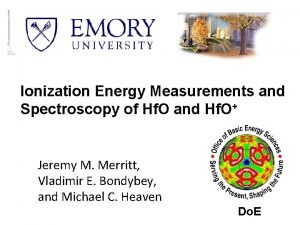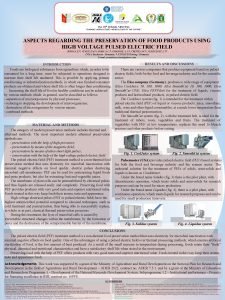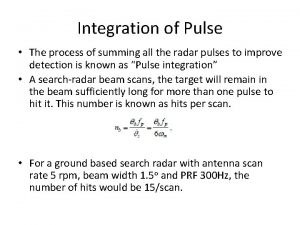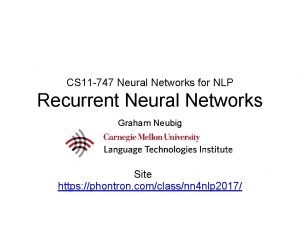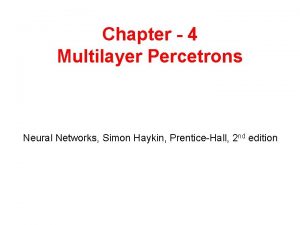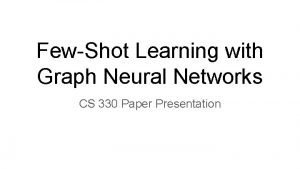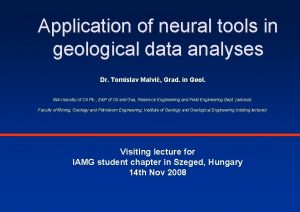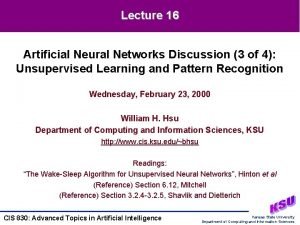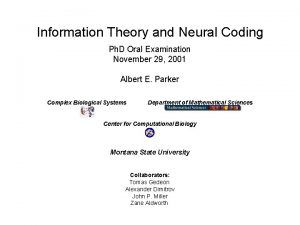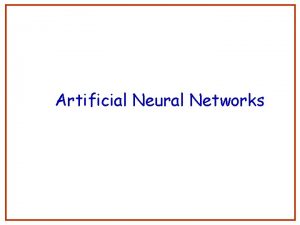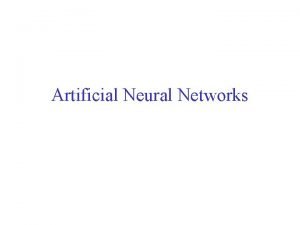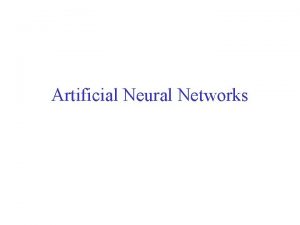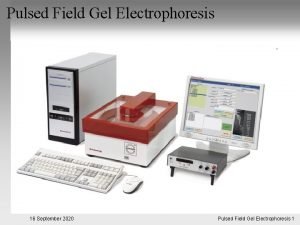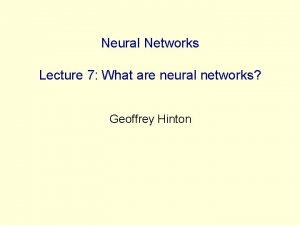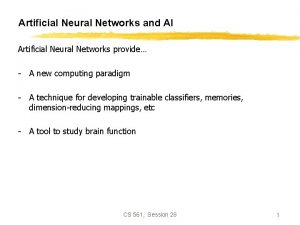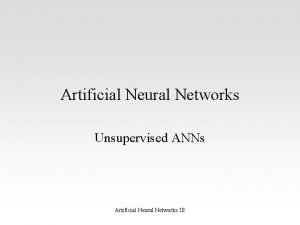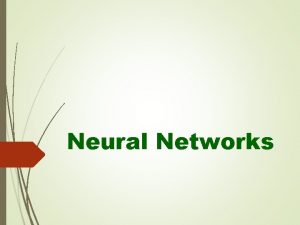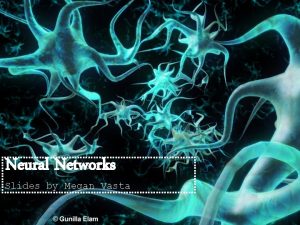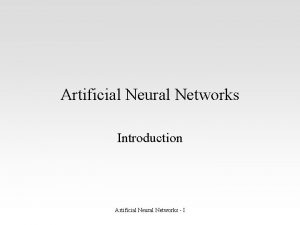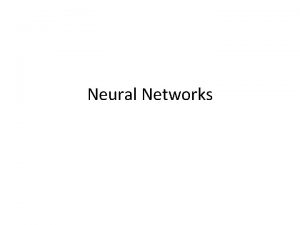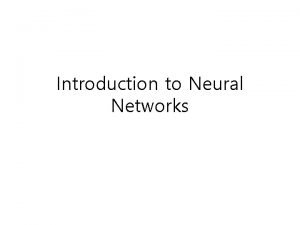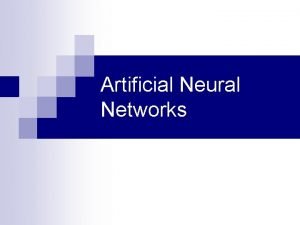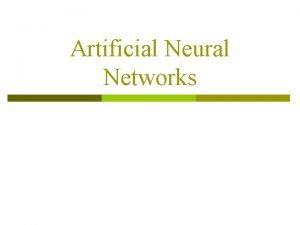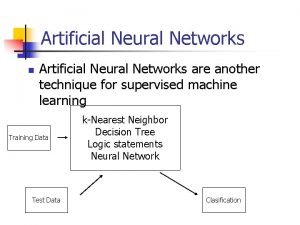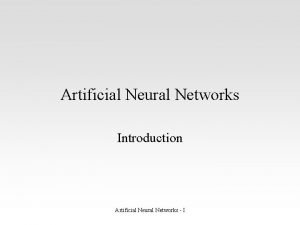Information Processing with Pulsed Neural Networks Ulrich Ramacher



















































- Slides: 51

Information Processing with Pulsed Neural Networks Ulrich Ramacher Corp. Research, Infineon Technologies AG, Munich ulrich. ramacher@infineon. com Prof. Ramacher, CPR ST 10 -Sep-20 Page 1

Dilemma (1) Prof. Ramacher, CPR ST 10 -Sep-20 Page 2 lack of robustness

Dilemma (2) Prof. Ramacher, CPR ST 10 -Sep-20 Page 3 lack of architecture information

Dilemma (3) • Non-invasive long-term recording of neural tissue. • High-density sensor with 128 Sensors in 1 1 mm². • Extended CMOS-process with biocompatible high-k surface dielectric. • Self-calibration circuitry and pre-amplification on chip. • Applications in neurobiology and drug discovery Sensor [m. V] Neuron [m. V] Infineon Neurochip 20µm Time [ms] Prof. Ramacher, CPR ST 10 -Sep-20 Page 4 Gap between signal processing by few cells and information processing by large arrays

Program 1. Use pulsed IAF neurons and adaptive synapses (inhibitory, excitatory) 2. Use experimental evidence 3. Start from simple, complete vision systems 4. Find basic network structures for information process 5. Find quantitative ansatz for information processing 6. Demonstrate usefulness for cell phones Prof. Ramacher, CPR ST 10 -Sep-20 Page 5

Neuron Model or : Rule 1: Reaching the threshold, a neuron resets membrane poten and starts sending a pulse of 1 ms Rule 2: A neuron either receives or sends deterministic dynamical system Prof. Ramacher, CPR ST 10 -Sep-20 Page 6

Experiment 1 Prof. Ramacher, CPR ST 10 -Sep-20 Page 7

Frequency Experiment 1 Prof. Ramacher, CPR ST 10 -Sep-20 Page 8

Observations • „Firing patterns don‘t come to an end“ • information processing is not a function of time Does frequency of firing patterns characterize t Inet = - pn x ln pn Is entropy a reproducible measure of informatio Prof. Ramacher, CPR ST 10 -Sep-20 Page 9

Experiment 2: Prof. Ramacher, CPR ST 10 -Sep-20 Page 10

Experiment 2 Prof. Ramacher, CPR ST 10 -Sep-20 Page 11

Findings • distribution function of fp‘s is independent of initial cond Inet = - pn x ln pn is a reproducibly measurable quantity Prof. Ramacher, CPR ST 10 -Sep-20 Page 12

Entropy as a function of mean synaptic weight Each color corresponds to a different realization of wij Network size: 40 neurons Prof. Ramacher, CPR ST 10 -Sep-20 Page 13

Network size: 40 neurons ISI Prof. Ramacher, CPR ST 10 -Sep-20 Page 14 Fire Rate

Synapse Model (proposed by U. Ramacher, April 99) Adaptation rule : local, causal, simple Prof. Ramacher, CPR ST 10 -Sep-20 Page 15

µ negative • 20 x 24 pixels , each connected to a neuron by a constant synapse • adaptive synapses connecting neighboured neurons Prof. Ramacher, CPR ST 10 -Sep-20 Page 16 synapses = coupled system of damped oscillators

µ positive 20 x 24 pixel, 10% noise synapses = coupled system of damped Prof. Ramacher, CPR STexponentially rising and falling „elements“ 10 -Sep-20 Page 17

Spot Detector = Illumination Encoder Prof. Ramacher, CPR ST 10 -Sep-20 Page 18

Pixels: 64 x 64 Prof. Ramacher, CPR ST 10 -Sep-20 Page 19

Projection onto the receptive field of a simple cell in the visual cortex LGN primary visual cortex (V 1) light retina Dr. Arne Heittmann Prof. Ramacher, CPR ST 10 -Sep-20 Page 20 stimulus optic nerve

convergence Dr. Arne Heittmann Prof. Ramacher, CPR ST 10 -Sep-20 Page 21

Modeling the Experiment Bright Stimulus Dark Stimulus y 0 Dy x 0 Dx Stimulus Stimuli projected onto RF of a Simple Cell Prof. Ramacher, CPR ST 10 -Sep-20 Page 22 P: measured pulse rate Gi: Gabor function H: Spot Intensity B: Background Intensity

Pulse difference detector (1) i 1>i 2 i 1<i 2 Prof. Ramacher, CPR ST 10 -Sep-20 Page 23

Pulse difference detector (2) Dynamics of the Synapse W 41: Prof. Ramacher, CPR ST 10 -Sep-20 Page 24

Pulse difference detector (3) Number of pulses Characteristic Neuron 2 Neuron 1 Neuron 4 i 2 Prof. Ramacher, CPR ST 10 -Sep-20 Page 25 i 1 = 0. 5 Q =1 WK 0 = 0. 08 td = 1 ms T = 0. 5 s

Architecture of feature detector (proposed by A. Heittmann, 2003) 1 1 1 3 --- 3 1 2 3 4 3‘ 3‘ 3‘ 3 4 4 2 4‘ 4‘ 4‘ 4 2 --- 2 3‘ 4‘ 5‘ 5 6 µ>0 µ<0 Prof. Ramacher, CPR ST 10 -Sep-20 Page 26 constant

Shaping the response-profile of the detector section of the retina Prof. Ramacher, CPR ST 10 -Sep-20 Page 27 H: Spot Intensity B: Background Intensity

Results of a detector implementation Gabor-Wavelet Prof. Ramacher, CPR ST 10 -Sep-20 Page 28 measured profile - 256 Gradient detectors - size of receptive field: 17 x 17 Pixel - T=750 ms @ 1 ms Pulse-duration

ideal Simulated Filter responses, T=750 ms Real Imaginary 90° 0° 0° Prof. Ramacher, CPR ST 10 -Sep-20 Page 29

The Head-Detector Restriction - single scale (keep eye-distance fixed) Prof. Ramacher, CPR ST 10 -Sep-20 Page 30

Check for Robustness in Eye-Brow Zone Reference Image Filter Response, horizontal direction region of interest 20 x 20 Pixel Prof. Ramacher, CPR ST 10 -Sep-20 Page 31 new eye-brow image

A simple memory (1) , 1 zone Learning Phase Detector Layer K K Prof. Ramacher, CPR ST 10 -Sep-20 Page 32 Input Layer Memory Layer K 1 -1 connection between input and detector layer 1 -1 connection between input and memory layer full connection between detector and memory layer

Experiment 1: learned image in input and memory Activity (number of events), 2 ms window Pulse-patterns of input-layer Prof. Ramacher, CPR ST 10 -Sep-20 Page 33

A simple memory (2), 1 Zone Recognition Phase Detector Layer K K Prof. Ramacher, CPR ST 10 -Sep-20 Page 34 Gabor Layer Memory Layer K 1 -1 connection between input and detector layer full connection between detector and memory layer

Experiment 3: recognition of non-learned eye-brow Activity (number of events), 2 ms window Pulse-patterns of input-layer Prof. Ramacher, CPR ST 10 -Sep-20 Page 35

Experiment 2: Isolated neurons Activity (number of events), 2 ms window Pulse-patterns of input-layer Prof. Ramacher, CPR ST 10 -Sep-20 Page 36

Zone-Architecture I Detector Layer 1 Horizontal Orientations Detector Layer 2 Memory Layer Vertical Orientations : Gabor-Kernel : Input Image Prof. Ramacher, CPR ST 10 -Sep-20 Page 37

Zone-Architecture II Zone 5 Zone 6 Zone 1 Zone 7 Zone 2 Zone 3 Zone 4 Zuordnung: Zonen zu Bildregionen : Zone für Gabor-Wavlet mit horizontaler Orientierung Prof. Ramacher, CPR ST 10 -Sep-20 Page 38 : Zone für Gabor-Wavlet mit vertikaler Orientierung

Reference-Image and Test-Images Reference-Image: Test-Images: Prof. Ramacher, CPR ST 10 -Sep-20 Page 39 Face 0001 Face 0014

Face 0001 Normalized accumulated activity Activity-Diagram Memory Zone 1 Detector Memory Zone 2 Detector Memory Detector Zone 3 Memory Detector Zone 4 Memory Detector Time [ms] Prof. Ramacher, CPR ST 10 -Sep-20 Page 40 Zone 5

Face 0011 Normalized accumulated activity Activity-Diagram Memory Zone 1 Detector Memory Zone 2 Detector Memory Detector Zone 3 Memory Detector Zone 4 Memory Detector Time [ms] Prof. Ramacher, CPR ST 10 -Sep-20 Page 41 Zone 5

Face 0014 Normalized accumulated activity Activity-Diagram Memory Zone 1 Detector Memory Zone 2 Detector Memory Detector Zone 3 Memory Detector Zone 4 Memory Detector Time [ms] Prof. Ramacher, CPR ST 10 -Sep-20 Page 42 Zone 5

Binding of zones by synchrony Binding Layer … 1 3 2 4 6 5 7 Zuordnung: Zonen zu Neuronen des Spotdetektors zur Bindung Prof. Ramacher, CPR ST 10 -Sep-20 Page 43 Memory Layer

Results ~ 40 ms Spot_0001 ~ 40 ms Spot_0011 Prof. Ramacher, CPR ST 10 -Sep-20 Page 44 ~ 40 ms Spot_0014

Column Architecture Image plane Detector Feature 1 Memory Feature 1 Zone 1 Detector Feature 2 Memory Feature 2 robust recognition Zone 2 . . . Detector Feature n Memory Feature n Binding Object 1 Associative Memory Binding Object 2 Binding Object n Prof. Ramacher, CPR ST 10 -Sep-20 Page 45 Zone n ∙ ∙ ∙ ∙

The vision: a 3 D-Vision-Cube The Vision-Cube • 3 D-stacking-architecture • Low-power • Real time capabilities • Integration of sensors and information processing • Distributes layers of information processing to layers of the stack • Solves problem of connectivity Prof. Ramacher, CPR ST 10 -Sep-20 Page 46 CMOS-sensor, sensor array Analogue-pulse conversion Feature-Detection Gabor-Wavelets, different orientations … Object-recognition Object-detection

Design of a testchip for the „Synchrony detector“, Base-Chip for the 3 D-Stack Infineon 130 nm CMOS-Technology pixel memory (1 Pixel) local AER-subcircuit testcircuits for 3 Dinterconnects Test circuit Integrate-and. Fire-Neuron 3 D-vias for supply and digital control signals adaptive synapses layout of 1 neuron rows of 3 D-vias for layer-to-layer signal distribution array of 128 x 128 neurons, 64 k synapses control circuit AER-encodercircuit Prof. Ramacher, CPR ST 10 -Sep-20 Page 47 Power consumption: 3 m. W @1. 5 V (analog) , 40 -250 m. W @1. 5 V (digital) Size: 7. 6 mm x 7. 8 mm

Gabor-Feature-Detector chip (layout) including a pulse router for the 3 D-integration Infineon 130 nm CMOS-Technology Array of 128 x 128 (64 k) processing elements for pulse processing and routing Processing element: - photo-Detector - pulse-processing (gradient detection) - dynamic routing of pulses 3 D- wiring channel for vertical signal distribution SRAM for storing routing information Digital macro: - routing circuit - configuration - AER-circuit (event based) Prof. Ramacher, CPR ST 3 D- wiring 10 -Sep-20 Page 48 for power supply and control signals

3 D-Stacking Chip 3 SOLID Connection Chip 2 15 µm 7 µm Chip 1 14 µm Layer 7 12 µm Layer 6 Layer 5 12µm Prof. Ramacher, CPR ST 10 -Sep-20 Page 49 Bottom-Chip

Real 3 D !! Layer 7 Layer 6 Layer 5 Layer 4 Layer 3 Layer 2 Bottom Substrate, Layer 1 Prof. Ramacher, CPR ST 10 -Sep-20 Page 50 13µm 7µm

Conclusion • IAF neurons, adaptive synapses, only • network built for -- Gabor wavelet based feature cascade -- memory -- comparison of memory and detector plane • synchrony of neurons indicative for -- robust recognition of memory feature at detector plane (elastic matching) -- binding of features as object • built in 130 nm CMOS -- synchrony detector -- Gabor wavelet detector -- 3 D stack of 7 silicon chips Prof. Ramacher, CPR ST 10 -Sep-20 Page 51
 Efficient processing of deep neural networks pdf
Efficient processing of deep neural networks pdf O,hf
O,hf Pulsemaster pulsed electric field
Pulsemaster pulsed electric field Pulsed coherent radar
Pulsed coherent radar Visualizing and understanding convolutional networks
Visualizing and understanding convolutional networks Vc bound
Vc bound Freed et al 2001 ib psychology
Freed et al 2001 ib psychology Audio super resolution using neural networks
Audio super resolution using neural networks Convolutional neural networks for visual recognition
Convolutional neural networks for visual recognition Style transfer
Style transfer Mippers
Mippers Stride in cnn
Stride in cnn Neural networks and learning machines 3rd edition
Neural networks and learning machines 3rd edition Pixelrnn
Pixelrnn Neural network matlab toolbox
Neural network matlab toolbox Neural networks for rf and microwave design
Neural networks for rf and microwave design 11-747 neural networks for nlp
11-747 neural networks for nlp Neural networks simon haykin
Neural networks simon haykin Sparse convolutional neural networks
Sparse convolutional neural networks On the computational efficiency of training neural networks
On the computational efficiency of training neural networks Tlu neural network
Tlu neural network Neural networks and fuzzy logic
Neural networks and fuzzy logic Netinsights
Netinsights Convolutional neural networks
Convolutional neural networks Few shot learning with graph neural networks
Few shot learning with graph neural networks Deep forest: towards an alternative to deep neural networks
Deep forest: towards an alternative to deep neural networks Convolutional neural networks
Convolutional neural networks Neuraltools neural networks
Neuraltools neural networks Lstm andrew ng
Lstm andrew ng Predicting nba games using neural networks
Predicting nba games using neural networks Neural networks and learning machines
Neural networks and learning machines The wake-sleep algorithm for unsupervised neural networks
The wake-sleep algorithm for unsupervised neural networks Audio super resolution
Audio super resolution Convolutional neural network alternatives
Convolutional neural network alternatives Difference between datagram and virtual circuit operation
Difference between datagram and virtual circuit operation Backbone networks in computer networks
Backbone networks in computer networks Neural processing
Neural processing Information theory and neural coding
Information theory and neural coding Bottom-up processing example
Bottom-up processing example Bottom up processing vs top down processing
Bottom up processing vs top down processing Bottom-up processing examples
Bottom-up processing examples Neighborhood processing
Neighborhood processing Secondary processing of wheat
Secondary processing of wheat Point processing
Point processing Histogram processing in digital image processing
Histogram processing in digital image processing Parallel processing vs concurrent processing
Parallel processing vs concurrent processing A generalization of unsharp masking is
A generalization of unsharp masking is Point processing in image processing
Point processing in image processing Morphological
Morphological Top down vs bottom up processing
Top down vs bottom up processing Batch processing and interactive processing
Batch processing and interactive processing Ulrich von jungingen
Ulrich von jungingen

